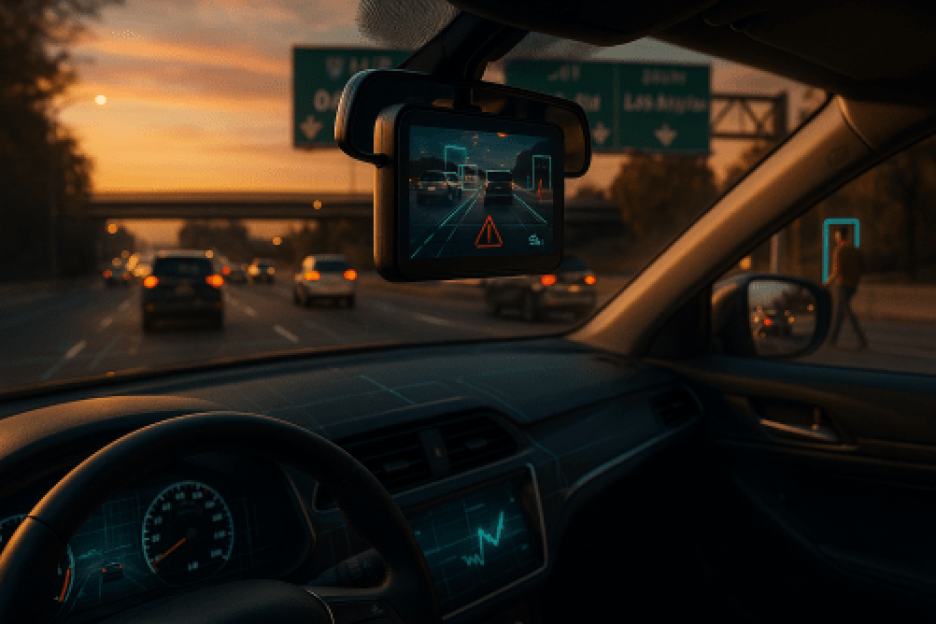You’re cruising down the interstate when suddenly, brake lights flash ahead like a red warning. In that split second, your car’s silent guardian awakens â not with sirens or alarms, but with intelligent precision that could mean the difference between a close call and catastrophe.
This isn’t science fiction; it’s the reality of AI dashcams transforming how Americans drive, protect themselves, and navigate our increasingly complex roadways.
What Makes AI Dashcams Different from Regular Car Cameras?
Traditional dashcams simply record footage, acting as passive witnesses to whatever unfolds on the road. AI dashcams, however, are like having a co-pilot with superhuman reflexes and 24/7 attention span. These smart car cameras use artificial intelligence to actively analyze road conditions, detect potential dangers, and even prevent accidents before they happen.
The key difference lies in real-time processing. While standard vehicle recording devices capture video for later review, AI-powered models interpret what they see instantly. They recognize pedestrians crossing unexpectedly, identify vehicles drifting into your lane, and can distinguish between a plastic bag blowing across the road and a genuine hazard requiring immediate attention.
Core AI Features That Set These Devices Apart
Advanced Driver Assistance Systems (ADAS) integration allows these intelligent dash cameras to communicate with your vehicle’s existing safety features. They don’t just record incidents â they help prevent them through:
- Collision warning systems that alert you to imminent impacts
- Lane departure notifications when you drift without signaling
- Forward collision alerts for sudden stops ahead
- Fatigue detection monitoring your driving patterns for signs of drowsiness
- Speed limit recognition through traffic sign identification
How AI Technology Powers Modern Dashcam Intelligence
The brain of an AI-enabled dashcam consists of specialized processors designed for computer vision and machine learning. These chips analyze up to 30 frames per second, processing millions of data points to understand complex traffic scenarios.
Object recognition algorithms form the foundation of dashcam intelligence. The system learns to identify:
- Different vehicle types (cars, trucks, motorcycles, emergency vehicles)
- Pedestrians and cyclists in various lighting conditions
- Traffic signals, signs, and road markings
- Weather conditions affecting visibility
- Parking spaces and obstacles during parking mode surveillance
Neural Networks and Deep Learning Integration
Modern smart dashcams employ convolutional neural networks (CNNs) trained on millions of driving scenarios. This deep learning technology enables the device to make nuanced decisions, like distinguishing between a child’s ball rolling into the street (high priority) versus leaves blowing across the pavement (low priority).
The edge computing capabilities mean all this processing happens directly on the device, ensuring real-time alerts without relying on internet connectivity. This local processing also protects your privacy since footage doesn’t need to be uploaded to cloud servers for analysis.
Essential AI Features Every Smart Dashcam Should Have
1. Forward Collision Warning (FCW)
This collision detection technology monitors the distance and relative speed between your vehicle and the one ahead. Using time-to-collision calculations, the system provides audible and visual warnings when it detects you’re approaching too quickly. The most advanced systems can distinguish between true collision risks and normal traffic flow, reducing false alarms.
2. Lane Departure Warning (LDW)
Lane keeping assistance technology tracks road markings and monitors your vehicle’s position within the lane. When the system detects unintentional lane changes (without turn signal activation), it provides immediate alerts. This feature proves especially valuable during long highway drives when attention might waver.
3. Driver Fatigue Detection
Drowsy driving prevention systems monitor your driving patterns, steering inputs, and even facial expressions through interior cameras. The AI learns your normal driving behavior and alerts you when it detects signs of fatigue, such as:
- Erratic steering patterns
- Extended periods without steering input
- Frequent lane corrections
- Drooping eyelids or yawning (with interior camera)
4. Traffic Sign Recognition (TSR)
Speed limit detection and broader traffic sign recognition keep you informed of current road conditions. The AI identifies speed limit signs, stop signs, yield signs, and construction warnings, displaying relevant information on your dashboard or smartphone app.
5. Parking Mode with AI Enhancement
Traditional parking surveillance simply records when motion is detected. AI-enhanced parking mode intelligently filters events, only saving footage when genuine security threats are identified. This smart filtering prevents your memory card from filling up with footage of swaying trees or passing clouds.
Top AI Dashcam Models for American Drivers in 2025
Premium Tier: Professional-Grade Protection
Nextbase iQ Series leads the premium segment with 4K resolution and comprehensive AI features. The system offers cloud connectivity for emergency services notification and includes Alexa integration for voice commands. Key features include:
- Emergency SOS automatic crash notification
- Intelligent parking mode with impact detection
- What3Words location sharing for precise emergency response
- Smart sense technology for reduced false alerts
BlackVue DR970X Plus combines dual-channel recording (front and rear) with advanced AI processing. The 4K Ultra HD front camera and Full HD rear camera provide complete vehicle coverage. Notable AI capabilities:
- Cloud dashcam features with remote live viewing
- Driver attention monitoring through facial recognition
- Automatic incident detection with cloud backup
- Speed camera database with real-time updates
Mid-Range Options: Balanced Performance and Value
Garmin Dash Cam 67W offers 180-degree field of view with essential AI safety features at a reasonable price point. The voice control functionality allows hands-free operation while driving. Core features include:
- Clarity HDR technology for challenging lighting conditions
- GPS logging with speed and location data
- Driver alerts for forward collisions and lane departures
- Incident detection with automatic file protection
Thinkware U1000 provides 4K front recording with optional rear camera addition. The super night vision 2.0 technology ensures clear footage in low-light conditions. AI enhancements include:
- ADAS calibration for personalized sensitivity settings
- Road safety warnings with visual and audio alerts
- Time-lapse recording for extended parking surveillance
- Mobile app integration for remote monitoring
Budget-Friendly AI Options
VIOFO A229 Pro delivers impressive AI capabilities at an accessible price point. The dual-channel system records both front and rear simultaneously with 2K resolution. Budget-conscious features:
- Built-in GPS module for location and speed tracking
- Parking mode surveillance with motion detection
- Loop recording with automatic file overwrite
- G-sensor protection for incident footage preservation
Installation and Setup: Getting Your AI Dashcam Road-Ready
Professional Installation vs. DIY Setup
Hardwired installation provides the cleanest look and enables parking mode functionality when your vehicle is turned off. Professional installation typically costs $100-300 but ensures proper fusing and wire routing. The installer will connect the dashcam to your vehicle’s fuse box, allowing continuous power while protecting your car’s electrical system.
DIY installation using the cigarette lighter adapter offers immediate functionality but limits some advanced features. This approach works well for renters or those preferring temporary installation. Most plug-and-play dashcams can be operational within minutes.
Optimal Camera Positioning
Mount your front-facing camera behind the rearview mirror, positioned to capture the maximum road view without obstructing your vision. The lens should sit approximately one-third down from the top of your windshield. For dual-camera systems, position the rear camera centrally in your back window, ensuring clear view of following traffic.
Camera angle calibration is crucial for AI functionality. Most systems include setup wizards that guide you through horizon alignment and ADAS calibration. Proper calibration ensures accurate distance measurements and reduces false alerts.
Memory Card Selection and Management
Choose high-endurance microSD cards designed for continuous recording. Class 10 or UHS-I cards with at least 64GB capacity provide reliable performance. Many AI dashcams support up to 256GB cards, offering weeks of loop recording storage.
Enable automatic file management to prevent storage issues. Most systems automatically delete oldest files when storage fills up, while protecting incident footage from overwrite. Set G-sensor sensitivity appropriately for your driving conditions â too sensitive creates excessive protected files, while too low might miss important events.
Understanding AI Dashcam Legal Considerations in the US
Recording Laws and Privacy Rights
Dashcam legality varies by state, with most allowing recording in public spaces where privacy expectations are minimal. However, audio recording laws differ significantly. Some states require two-party consent for audio recording, making it safer to disable microphone functionality in these jurisdictions.
Public recording rights generally protect dashcam use on public roads, but private property recording may require permission. Always check local regulations, especially for commercial vehicle use where additional restrictions might apply.
Evidence Admissibility in Legal Proceedings
Dashcam footage is generally admissible in US courts, but timestamp accuracy and file integrity are crucial factors. AI dashcams with GPS synchronization and tamper-proof storage provide stronger legal evidence. The metadata included with AI-processed footage can actually strengthen its legal value by providing additional context.
Insurance claim support often benefits from AI-enhanced footage, as the system’s analysis can help demonstrate fault clearly. Many insurance companies now offer discounts for vehicles equipped with certified dashcams, recognizing their value in reducing fraudulent claims.
Data Privacy and Cloud Storage
Cloud-connected dashcams raise additional privacy considerations. Review manufacturer privacy policies carefully, understanding what data is collected, stored, and shared. Choose systems offering local storage options if privacy is a primary concern.
Data encryption protects your footage from unauthorized access. Look for systems using AES encryption for cloud uploads and secure authentication for mobile app access.
Maximizing Your AI Dashcam’s Effectiveness
Regular Maintenance and Updates
Firmware updates often include improved AI algorithms and new features. Enable automatic updates when connected to WiFi, or check manufacturer websites monthly for new releases. Updated AI models typically offer better object recognition and reduced false alerts.
Lens cleaning significantly impacts AI performance. Use microfiber cloths and appropriate cleaning solutions weekly, or more frequently in dusty conditions. Dirty lenses can cause AI systems to misinterpret objects or miss important details.
Optimizing Settings for Your Driving Environment
Urban driving requires different sensitivity settings than highway cruising. Adjust collision warning distance based on typical traffic patterns in your area. City drivers might prefer shorter warning distances to reduce alerts in stop-and-go traffic, while highway drivers benefit from longer detection ranges.
Night mode optimization ensures AI features function effectively in low-light conditions. Many systems offer automatic adjustment, but manual fine-tuning based on your typical driving times can improve performance.
Integration with Vehicle Systems
OBD-II connectivity available on some AI dashcams provides additional vehicle data integration. This connection enables engine diagnostic information recording and more accurate speed detection. The enhanced data improves incident analysis and provides valuable maintenance insights.
Smartphone integration through dedicated apps allows real-time monitoring and remote configuration. Most AI dashcams offer iOS and Android apps for viewing footage, adjusting settings, and receiving notifications about detected incidents.
The Future of AI Dashcam Technology
Emerging Technologies and Features
5G connectivity will enable real-time cloud processing and vehicle-to-vehicle communication. Future AI dashcams may share hazard information between vehicles, creating collaborative safety networks that warn drivers of conditions beyond their immediate view.
Augmented reality displays integrated with AI analysis could project safety information directly onto windshields. This technology would overlay collision warnings, navigation guidance, and hazard alerts in your direct line of sight.
Integration with Autonomous Driving
As self-driving technology develops, AI dashcams will likely evolve into comprehensive autonomous driving recorders. These systems would monitor not just road conditions but also the performance of autonomous systems, providing crucial data for improving self-driving safety.
Machine learning advancement continues improving AI accuracy and reducing false alerts. Future systems may learn individual driving preferences and habits, providing personalized safety recommendations based on your specific driving patterns.
Smart City Integration
Connected infrastructure development allows AI dashcams to receive real-time information from smart traffic systems. This integration could provide advance warning of traffic light changes, construction zones, or emergency vehicle approaches.
Crowd-sourced safety data from AI dashcam networks helps identify recurring hazards and improve road safety for entire communities. Anonymous data sharing could highlight dangerous intersections or road conditions requiring municipal attention.
Cost Analysis: Investment vs. Protection Value
Initial Purchase Considerations
AI dashcam prices range from $200 for basic models to $800+ for premium systems with full ADAS integration. Consider the total cost of ownership, including memory cards, installation, and potential subscription fees for cloud services.
Insurance discount programs offered by many carriers can offset purchase costs. Some insurers provide 5-15% discounts for vehicles with certified safety devices, making AI dashcams essentially pay for themselves over time.
Long-term Value Proposition
Accident prevention represents the greatest potential savings. Even preventing one minor collision can save thousands in deductibles, increased premiums, and vehicle repairs. The peace of mind value is immeasurable for many drivers, especially those with teen drivers or high-mileage commutes.
Fleet management benefits for business owners include reduced liability exposure, improved driver behavior, and potential commercial insurance discounts. The ROI calculation for commercial applications often justifies premium AI dashcam investments.
Making the Right Choice for Your Needs
Assessing Your Driving Profile
Daily commute analysis helps determine necessary features. Urban commuters benefit most from parking surveillance and collision detection, while highway drivers prioritize lane departure warnings and fatigue detection.
Vehicle compatibility ensures optimal performance. Check mounting options, power requirements, and smartphone integration before purchase. Some luxury vehicles have built-in dashcam preparation that simplifies installation.
Feature Prioritization
Essential features for most drivers include automatic incident detection, loop recording, and basic ADAS warnings. Nice-to-have features like cloud connectivity and voice control add convenience but aren’t critical for basic safety benefits.
Future expansion capabilities allow system growth as needs change. Choose systems supporting additional cameras, external sensors, or OBD-II integration if you might want these features later.
Conclusion: Your Road to Smarter, Safer Driving
AI dashcams represent a fundamental shift from passive recording to active safety enhancement. These intelligent guardians don’t just document your journey â they actively work to ensure you complete it safely. As American roads become more complex and traffic increases, the preventive power of AI technology becomes not just beneficial but essential.
The investment in an AI dashcam extends far beyond the initial purchase price. You’re investing in peace of mind, legal protection, and most importantly, the safety of yourself and your loved ones. Whether you choose a budget-friendly option with basic AI features or a premium system with comprehensive ADAS integration, you’re taking a proactive step toward safer driving.
As technology continues advancing, early adopters of AI dashcam technology position themselves at the forefront of automotive safety innovation. The question isn’t whether AI will become standard in vehicle safety â it’s whether you’ll embrace this protection now or wait until it becomes mandatory.
Your next trip begins the moment you start your engine. Make sure your AI co-pilot is ready to help you navigate whatever the road brings. The future of driving isn’t just about reaching your destination â it’s about arriving safely, every single time.







